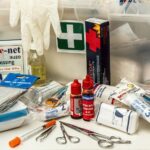Let me tell you something about myself and how I consume information. It must be clear, concise, to-the-point, and well explained without any unnecessary steps. I only need the facts. A recipe without the facts would leave me completely confused and unable to understand it. You can also buy sourdough starter from Get Sourdough and have it shipped to your door.
What is a Sourdough Starter?
This is the start of homemade, artisanal sourdough bread. It’s essentially flour and water mixed together. The starter activates wild yeast in the flour to give rise to the perfect loaf of homemade bread. This is right: When you use the starter to bake bread, there’s no need to add instant yeast or dry yeast. The natural yeast is already active and present.
How do I make a starter of sourdough?
Two ingredients are all you need, and a vessel capable of handling the chemistry involved in the process. I recommend that you use glass. It is also helpful to have a way of weighing your starter, ingredients, and bottle.
- Whole Wheat Flour (You could also use Rye, or a combination of both)
- Water (around 80deg)
- Digital scale (not necessary, but very useful)
- Glass Jar, Mason Jar or Bottle. I recommend 32 oz. for space and growth/doubling after each feeding.
How do I feed it?
Regularly feed your sourdough starter with equal amounts of flour (unbleached), and water. Your sourdough starter can be fed with any combination of grains-based flours.
How to Make Sourdough Starter
You can use a digital scale, which I highly recommend, but it is not necessary. The first thing you should do to weigh your starter and record it. It’s also a good idea to keep a journal with notes at the beginning. You’ll be able to keep track of the starter’s weight even if it doesn’t leave its home. This is especially useful if you weigh everything, but it is possible to use other methods of weighing if you don’t have a scale.
Measure your flour and add water. Make sure it is hot enough. Tap water is acceptable as long as it does not contain too much chlorine.
Mix the two together in a jar. Make sure you don’t have any dry flour. Once the flour is incorporated, mix it until it forms a paste.
To allow expansion and for some gases to escape, cover loosely.
Allow it to rest for 24 hours in a cool, dark place.
Begin your daily feeding routine after 24 hours. Refer to the detailed recipe at the bottom of the page.
Seriously, that’s it. There are only two ingredients. And time. You have five minutes to stretch each morning. Give your starter five minutes while it grows. Simple.
TROUBLESHOOTING
Why doesn’t my starter sourdough have bubbles?
Happy sourdough starters should be active and bubbly. The starter’s live yeast and bacteria feeds on the sugars in flour, and expels CO2. These ‘bubbles form’. Bubbles usually form within 4 to 12 hours after each feeding.
If you don’t see any bubbles, your starter has probably run out of food (flour). It should be fed more often. If your starter is fed every 12 hours, an increase in the frequency of feeding may help it recover. Feed your starter every 8-12 hours until normal activity returns.
If your starter for sourdough isn’t rising
A good starter of sourdough takes time to rise and fall in a predictable manner. These are some of the factors that will help you achieve this.
Use water that is free of chlorine/chloramine. These chemicals can disrupt or kill yeast fermentation.
Temperature of water and environment are also important factors. Yeast prefers warmer environments.
Too hot temperatures could cause yeast to die. If you don’t have any other options, a moderate 80F (26degC), is the ideal temperature.
You might try putting your starter in the oven while the light is on. An oven bulb emits a gentle heat that will aid the process if necessary.
Regular water and flour intakes will ensure that the yeast is happy and healthy.
What amount of sourdough starter should I throw out?
You should throw away at most half of your starter each feeding. This is because your starter requires so much flour every time it’s fed that it becomes too heavy to handle if it wasn’t first thrown away.
What happens if a starter of sourdough goes bad?
The starter should smell pleasant and mildly sour. It should also be light in color. Starters that start to form spots of pink, green or dark brown should be thrown out.
What is the Best Time to Bake with It?
The best time to use your starter is when it is at its highest height. This is when it has doubled in size. Mix the starter until it forms bubbles. Then, add a teaspoon of starter to a bowl of warm water. If the starter floats, it is ready to use. If it sinks to the bottom, let it rest for a few more hours.
What should it smell like?
A starter that is good should smell sweet but not too sweet due to fermentation. However, it should not smell like garbage or socks.
What should I do if dark liquid appears on my starter?
A dark liquid may appear on the culture’s surface or throughout it during the creation process. It can have a strong, unpleasant smell similar to gym socks or rubbing alcohol. This is known as “hooch” because it indicates that your starter needs to be fed. It is best to get rid of this liquid along with any starter that has become discolored if you find it.
Below is a picture I took of my starter sourdough after it was gone for six weeks. Yes, I know. But I was busy with a baby so I forgot to keep it in the fridge. It took me only 24 hours to return it to a healthy and happy starter, as I had followed the instructions.
How to Make a Sourdough Starter
- Proper starter growth requires consistent feedings at the same time each day.
- The temperature controls the environment and water for feeding. Ideal is a moderate 80degF (26degC).
- Be persistent! It takes time to create a starter that is strong enough for baking bread.
- Good starters should have a sweet, yeasty smell.
- If you are making bread, make sure the starter is at its peak level of rising and has lots of bubbles. To make sure your starter is ready, use the water float test.
- To measure the growth of the starter, place a rubber band around it or a piece of masking tape around it.





